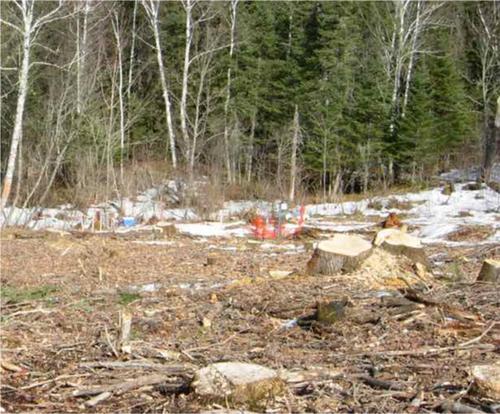当前位置:
X-MOL 学术
›
Hydrol. Process.
›
论文详情
Our official English website, www.x-mol.net, welcomes your feedback! (Note: you will need to create a separate account there.)
Changes in hillslope hydrology in a perched, shallow soil system due to clearcutting and residual biomass removal
Hydrological Processes ( IF 3.2 ) Pub Date : 2020-10-21 , DOI: 10.1002/hyp.13948 Colin P. R. McCarter 1 , Stephen D. Sebestyen 2 , Susan L. Eggert 2 , Randall K. Kolka 2 , Carl P. J. Mitchell 1
Hydrological Processes ( IF 3.2 ) Pub Date : 2020-10-21 , DOI: 10.1002/hyp.13948 Colin P. R. McCarter 1 , Stephen D. Sebestyen 2 , Susan L. Eggert 2 , Randall K. Kolka 2 , Carl P. J. Mitchell 1
Affiliation

|
Sustainable fuels legislation and volatility in energy prices have put additional pressures on the forestry sector to intensify the harvesting of biomass for “advanced biofuel” production. To better understand how residual biomass removal after harvest affects forest hydrology in relatively low slope terrain, a Before‐After‐Control‐Impact (BACI) study was conducted in the USDA Forest Service's Marcell Experimental Forest, Minnesota, USA. Hydrological measurements were made from 2010–2013 on a forested hillslope that was divided into three treatment blocks, where one block was harvested and residual biomass removed (Biomass Removed), the second was harvested and residual biomass left (Biomass Left), and the last block was left as an Unharvested Control. The pre‐harvest period (2 years) was 2010–11 and post‐harvest (2 years) was 2012–13. Water table elevation at the upslope and downslope position, subsurface runoff, and soil moisture were measured between May–November. Mixed effect statistical models were used to compare both the before‐after and “control” treatment ratios (ratios between harvested hillslopes and the Unharvested Control hillslope). Subsurface runoff significantly increased (p < .05) at both harvested hillslopes but to a greater degree on the Biomass Left hillslope. Greater subsurface runoff volumes at both harvested hillslopes were driven by substantial increases during fall, with additional significant increases during summer on the Biomass Left hillslope. The hydrological connectivity, inferred from event runoff ratios, increased due to harvesting at both hillslopes but only significantly on the Biomass Left hillslope. The winter harvest minimized soil disturbance, resulting in no change to the effective hydraulic conductivity distribution with depth. Thus, the observed hydrological changes were driven by increased effective precipitation and decreased evapotranspiration, increasing the duration that both harvested hillslopes were hydrologically active. The harvesting of residual biomass appears to lessen hydrological connectivity relative to leaving residual biomass on the hillslope, potentially decreasing downstream hydrological impacts of similar forestry operations.
中文翻译:

截割和残留生物量的清除导致高位浅层土壤系统中坡地水文学的变化
可持续燃料立法和能源价格波动给林业部门带来了更大的压力,以加大对“先进生物燃料”生产的生物量的收获。为了更好地了解采伐后残留生物量的去除如何在相对低坡度的地形上影响森林水文,美国农业部森林服务局的马赛尔实验森林在美国明尼苏达州进行了一次“后控制后影响”研究。从2010年至2013年,对森林山坡进行了水文测量,将其分为三个处理区块,其中一个区块被收获并去除了残余生物量(去除了生物质),第二个收获了,剩余了残留生物量(了生物质左),最后一个块保留为未收获控件。收获前(2年)为2010-11年,收获后(2年)为2012-13年。在5月至11月之间测量了上坡和下坡位置的地下水位高度,地下径流和土壤湿度。使用混合效应统计模型来比较前后处理率和“对照”处理率(收获的山坡与未收获的对照山坡之间的比率)。地下径流显着增加(p <.05)在两个已收获的山坡上,但在更大的程度上是在生物质左山坡上。两个收获山坡的地下径流量都较大,这是由于秋季期间的大量增加所致,而夏季生物量左坡上的额外显着增加。从事件径流比推断出的水文连通性由于两个山坡的收获而增加,但仅在生物质左山坡上明显增加。冬季收获使土壤扰动最小化,导致有效的水力传导率分布不会随深度变化。因此,观测到的水文变化是由有效降水增加和蒸散量减少驱动的,从而延长了两个已收获的山坡在水文上的活动时间。
更新日期:2020-11-03
中文翻译:

截割和残留生物量的清除导致高位浅层土壤系统中坡地水文学的变化
可持续燃料立法和能源价格波动给林业部门带来了更大的压力,以加大对“先进生物燃料”生产的生物量的收获。为了更好地了解采伐后残留生物量的去除如何在相对低坡度的地形上影响森林水文,美国农业部森林服务局的马赛尔实验森林在美国明尼苏达州进行了一次“后控制后影响”研究。从2010年至2013年,对森林山坡进行了水文测量,将其分为三个处理区块,其中一个区块被收获并去除了残余生物量(去除了生物质),第二个收获了,剩余了残留生物量(了生物质左),最后一个块保留为未收获控件。收获前(2年)为2010-11年,收获后(2年)为2012-13年。在5月至11月之间测量了上坡和下坡位置的地下水位高度,地下径流和土壤湿度。使用混合效应统计模型来比较前后处理率和“对照”处理率(收获的山坡与未收获的对照山坡之间的比率)。地下径流显着增加(p <.05)在两个已收获的山坡上,但在更大的程度上是在生物质左山坡上。两个收获山坡的地下径流量都较大,这是由于秋季期间的大量增加所致,而夏季生物量左坡上的额外显着增加。从事件径流比推断出的水文连通性由于两个山坡的收获而增加,但仅在生物质左山坡上明显增加。冬季收获使土壤扰动最小化,导致有效的水力传导率分布不会随深度变化。因此,观测到的水文变化是由有效降水增加和蒸散量减少驱动的,从而延长了两个已收获的山坡在水文上的活动时间。



























 京公网安备 11010802027423号
京公网安备 11010802027423号